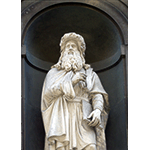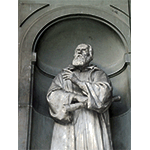Galleria degli Uffizi [Uffizi Gallery]
Founded in 1560, the Uffizi was built at the order of Cosimo I de' Medici, to the project of Giorgio Vasari, to serve as offices for the most important municipal bureaus. In 1565 the construction of the "Corridor" that joined the Uffizi to Palazzo Vecchio and Palazzo Pitti was begun. After the death of both the Grand Duke and his architect, in 1574, the work was continued by Bernardo Buontalenti and finished in 1580. It is known that, already by 1581, Grand Duke Francesco I had set up a gallery on the top floor in which to conserve and display his collections. This is the birth certificate of one of the world’s most important museums, a great collection of art and science. The heart of the Gallery is the Tribuna of Buontalenti: of octagonal plan, modelled on the Tower of the Winds in Athens, it is imbued with symbolic allusions to the cosmic order. Next to the Tribuna, the "Stanzino", or Cabinet, contains charts and scientific instruments.
Between 1587 and 1591 the series of paintings representing illustrious men, the so-called Jovian series, inspired by the model of the museum belonging to the erudite Paolo Giovio, was hung in the corridors of the Uffizi. This was the first and most important core of the rich iconographic collection destined to be further enriched over the course of the centuries. Among the personages portrayed are many scientists: Giovanni Alfonso Borelli, Robert Boyle, Thyco Brahe, Descartes, Antonio Cocchi, Galileo Galilei, Guido Grandi, Giovanni Kepler, Alessandro Marchetti, Pietro Andrea Mattioli, Girolamo Mercuriale, Isaac Newton, John Ray, Francesco Redi, Niccolò Stenone, Evangelista Torricelli, and Vincenzo Viviani.
While today the core collections consist essentially of paintings and the gallery of statues, in the museum's original conception art collections coexisted with naturalist specimens, scientific instruments and an armoury. Peter Leopold, who made an overall reorganisation of the Gallery, transferred the scientific collections to the Museum of Physics and Natural History. Today the minerals, stuffed animals, fossils, measurement instruments and objects of scientific interest in general are found mainly in the various sections of the University of Florence Museum of Natural History and the Institute and Museum of the History of Science.
****************************
Texts by Alessandro Tosi
English translation by Catherine Frost
Last update 15/apr/2008





